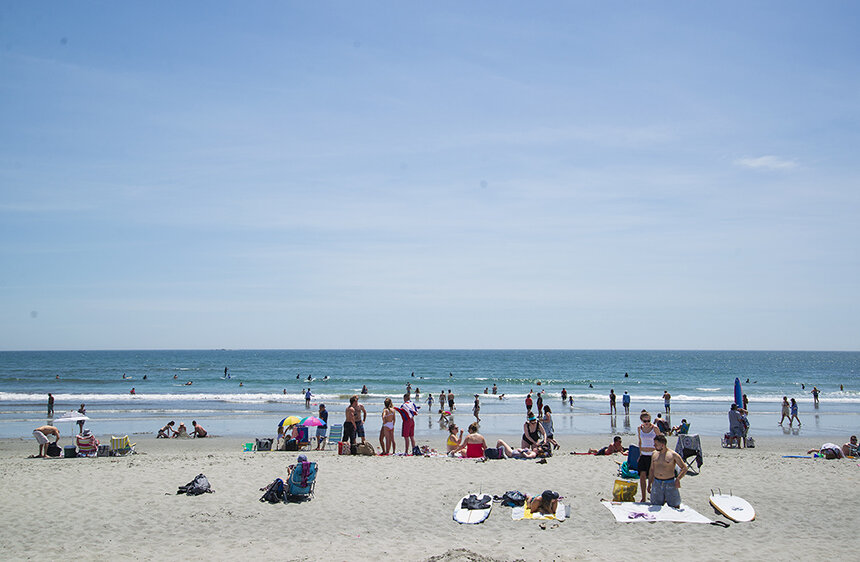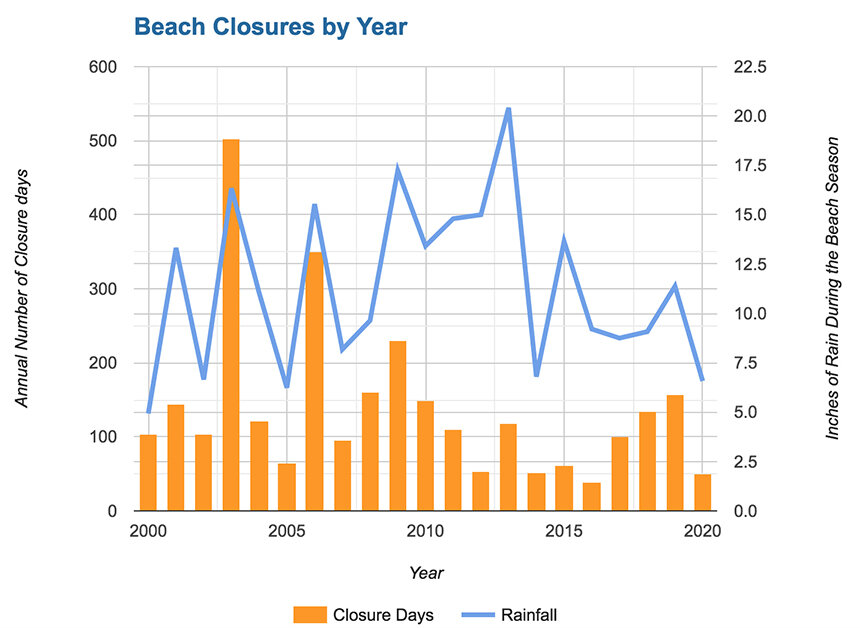R.I. Beach Health Responds to Better Stormwater Management
By FRANK CARINI/ecoRI News staff
 |
| Beachgoers enjoy a sunny day at Second Beach in Middletown. Beach closures in Rhode Island are trending downward. (Joanna Detz/ecoRI News) |
Many of the changes witnessed along Rhode Island’s coastline during the past two decades are noticeable and concerning, especially when it comes to the impact on the brick-and-mortar environment that replaced the natural world.
The seaside town of South Kingstown provides a telling example of Mother Nature’s brisk alternations. Less than 20 years ago, a sandy carpet fronted Matunuck Beach Road and Ocean Mist, an iconic Ocean State watering hole.
That carpet of disintegrated rock and fine
mineral particles has largely been replaced by briny water. The Atlantic Ocean
now laps beneath beachfront bars and restaurants and is advancing on the
infrastructure buried beneath Matunuck Beach Road.
There
are, however, unseen changes to the Ocean State’s waterfront that are cause for
optimism.
The
amount of sand in front of them may be shrinking, but water quality at Rhode
Island’s signature attractions — its tourist-filled, economically important
beaches — is improving.
 |
| Beach closures in Rhode Island have been closely tied to precipitation, so reducing stormwater runoff plays an important role in limiting contamination risks. (DOH) |
In the first decade of the 2000s, beach closures were trending in the wrong direction. In 2003, Rhode Island beaches were closed a staggering 503 times because high levels of bacteria, usually following a rainstorm, made them unsafe.
Three
years later, in 2006, Rhode Island lost a combined 351 summer beach days. The
most beach days lost to unsafe water quality since then was 2009’s 230. Last
year, the Ocean State experienced 51 closure days. So far this year, five
marine beaches — Goddard State Park Beach and Conimicut Point Beach in Warwick,
Easton’s Beach on Newport, Third Beach in Middletown and Mackerel Cove Beach in
Jamestown — have been closed to swimming for a total of 19 days during what so
far has been a wet summer.
The
closure of Rhode Island beaches is closely linked to precipitation — the more
we get the more stress on our coastal waters. Wind direction, currents and the
tides also play a role.
Stormwater
runoff from roads, parking lots, roofs and other impervious surfaces washes
contamination, including bacteria and other pathogens, into the Ocean State’s
salt waters, either directly or indirectly via freshwater pathways. Wastewater
overflows, made possible by heavy amounts of rain, also deliver contaminants,
such as fecal coliforms, escherichia coli and enterococci, to beach waters.
In
2010, a year after Rhode Island saw 230 beach days lost to polluted waters,
that number dropped to 149. The state received about 4 inches less of rain
during the 2010 beach season — Memorial Day to Labor Day — but the drop also
coincided with Phase I of the Narragansett Bay Commission’s Combined Sewer Overflow Abatement Program going online. Phase
II went online six years later.
The
Phase I tunnel built beneath Providence stores combined sewer and stormwater
during heavy rains. Once a storm has passed, this combined wastewater is
treated before being released into Narragansett Bay. The second phase finished
in 2014 reduced discharge from 17 sewer overflows in the bay’s watershed.
The
Narragansett Bay Commission’s hundreds of millions of dollars of work has been
complemented by green infrastructure projects in the watershed municipalities
of Newport, Warren, Barrington and Bristol, to name a few.
 |
| Bioretention rain gardens in the parking lot of Bristol Town Beach have helped reduce the amount of stormwater that reaches the beach unfiltered. (Frank Carini/ecoRI News) |
At Bristol Town Beach, for example, the town installed a new parking lot with six bioretention rain gardens, which allow runoff to be filtered through native vegetation before it’s transported to an underground drainage basin.
An hydrodynamic separator system was also installed to capture fine-particulate pollutants, and a vegetated swale was added at the outfall of the drainage system, which removes silt and pollution from stormwater.
Other
projects were multimillion-dollar efforts that took considerable coordination
and/or public buy-in. The city of Warwick has removed thousands of cesspools
and installed municipal sewer connections in the Oakland Beach area. The work
has helped highly stressed Oakland Beach address its long history of
water-quality issues.
The
$6 million Easton’s Beach UV Stormwater Disinfection System treats polluted runoff
before it’s released into Easton’s Stream, which empties in the popular
Aquidneck Island beach. The ultraviolet system of lights began operating in May
2011 and has helped reduce the number of days Easton’s Beach and Atlantic Beach
have been closed to swimming.
Of
course, the combined sewer overflow work done in Providence and other projects
undertaken in the Narragansett Bay watershed didn’t help beaches along Rhode
Island’s open-ocean South County coast or those in Little Compton.
Stormwater
management projects at and around beaches statewide have helped decrease the
amount of polluted runoff making its way into Rhode Island waters of all shapes
and sizes. The installation of rain gardens, rain barrels and bioswales,
finding illicit discharges, the ripping up unnecessary pavement and concrete,
fixing broken pipes, and, yes, increased street sweeping have reduced and
filtered stormwater flow.
All
of these efforts, both large and small, are making a difference, as beach
closures are trending down. In 2013, Rhode Island’s four-month beach season got
soaked with nearly 20.5 inches of rainfall — the highest amount of summer rain
recorded in the past two decades by 3.2 inches. That season 119 beach days were
lost. In comparison, the combined 503 beach days lost in 2003 happened during a
beach season that experienced 16.3 inches of rainfall.
ecoRI News recently spoke with Courtney Schmidt, staff scientist for the Narragansett Bay Estuary Program (NBEP), about the state of Rhode Island’s beaches. Every five years the NBEP publishes a report on the state of Narragansett Bay and its watershed. The most recent report, published in 2017, notes state and local agencies monitor Narragansett Bay’s 37 licensed beaches and close individual beaches when water tests show high counts of bacteria.
The
Rhode Island standard for enterococci, found in human and animal waste, is a
maximum of 60 colony-forming units (cfu) per 100 milliliters in both fresh and
saltwater beaches. Anything above that is considered unsafe for recreational
use. Additional factors are also taken into account when closing a
beach, including history of contamination, precipitation and flushing rates, as
it can take up to three days for the results of bacterial tests to be returned.
“We
have healthy beaches on the whole,” Schmidt said. “But monitoring beach water
quality, especially those beaches in highly developed areas, remains a
priority.”
The
Warwick resident said the Department of Health and Department of Environmental
Management do an excellent job monitoring the health of Rhode Island’s 67
licensed marine beaches.
She
noted, however, that beach health “is a very local issue” that demands local
stormwater and pollution problems be addressed locally.
Among
the areas where beach pollution remains a high concern, despite local efforts
to address the problem, is Greenwich Bay. Its beaches, such as Oakland Beach,
Buttonwoods Beach and Conimicut Point Beach, which is responsible for 12 of the
19 lost beach days this summer, face some of the most challenging impairment
issues in Rhode Island.
Greenwich
Bay, circled by development, is a prime example of a host of pollution issues
from multiple sources — stormwater runoff and septic and cesspool leakage,
according to Schmidt. Those problems are exacerbated by the fact Greenwich Bay
doesn’t flush well or quickly.
While
steps are being taken to address the issues plaguing Greenwich Bay beaches,
bacterial levels in the waters of the Providence River have dropped by at least
50 percent, according to Schmidt.
“The
idea of opening an urban beach is closer than ever before,” she said.
The
state’s Urban Beach Initiative is tracking water-quality improvements at four
places in upper Narragansett Bay: Bold Point and Fields Point in Providence and
Rose Larisa Memorial Park and Sabin Point in East Providence.
“Fields
Point and Bold Point appear to be approaching conditions at three urban beaches
that are open for swimming, Barrington, Warren and Bristol town beaches,”
according to the 2019 Rhode Island Beach and Recreational Water Quality Report.
But
even as strides have been made since 2000 to reduce the number of Rhode Island
beach days lost to pollution, the climate crisis is keeping the pressure on the
state’s already-stressed marine waters. For one, warmer waters will create
conditions for bacteria and harmful algae to thrive and grow.
“How
we sustain and protect this resource that is part of our culture and a big part
of our economy will require equitable decisions,” Schmidt said.
To
check the status of a beach you plan to visit, click here.